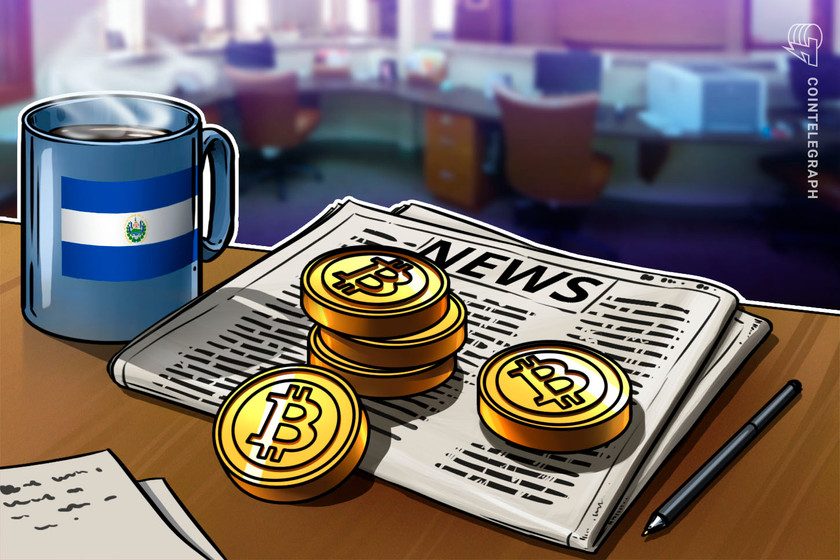Inflationary vs. deflationary cryptocurrencies, Explained
What is Bitcoin? How does blockchain work? How to mine cryptocurrency? We are glad to help you answer these questions with our quick guides in Explained section.
rn”,”seo_description”:”What is Bitcoin? How does blockchain work? How to mine cryptocurrency? We are glad to help you answer these questions with our quick guides in Explained section.”},”words_count”:861,”description”:” Inflationary cryptocurrencies have a continuously increasing supply, while deflationary cryptocurrencies have a decreasing supply.rn “,”author”:{“id”:1635,”title”:”Alexandra Overgaag”,”url”:”alexandra-overgaag”,”twitter”:””,”google_plus”:””,”photo”:null,”gender”:”male”,”description”:”A Web3 advocate who graduated in Politics & Digital Technologies (MAS), International Relations & European Studies (MSc) and Law. Alexandra is a business strategist, trader and writer and is passionate about education and generating new ideas by taking a multi-disciplinary perspective.”,”facebook”:””,”email”:””,”linkedin”:””,”created_at”:”2022-09-01 12:43:19″,”updated_at”:”2022-09-01 12:43:19″,”deleted_at”:null,”innovation_circle_url”:null,”avatar”:”https://cointelegraph.com/assets/img/icons/author_male.jpg”,”hash”:”aHR0cHM6Ly9jb2ludGVsZWdyYXBoLmNvbS9hdXRob3JzL2FsZXhhbmRyYS1vdmVyZ2FhZw==”,”relativeUrl”:”https://cointelegraph.com/authors/alexandra-overgaag”,”user_id”:1635,”language_id”:1,”name”:”Alexandra Overgaag”,”desc”:”A Web3 advocate who graduated in Politics & Digital Technologies (MAS), International Relations & European Studies (MSc) and Law. Alexandra is a business strategist, trader and writer and is passionate about education and generating new ideas by taking a multi-disciplinary perspective.”,”seo_title”:””,”seo_description”:””,”enabled”:0,”show_in_authors”:0,”show_in_experts”:0},”category_id”:65,”audio”:”https://s3.cointelegraph.com/audio/103515.c9e92062-514d-4614-b276-7162fb35a510.mp3″,”tags”:[{“name”:”Bitcoin”,”uri”:”/tags/bitcoin”,”super”:1,”page_title”:”Bitcoin News”},{“name”:”Cryptocurrencies”,”uri”:”/tags/cryptocurrencies”,”super”:0,”page_title”:”Cryptocurrencies News”},{“name”:”Altcoin”,”uri”:”/tags/altcoin”,”super”:1,”page_title”:”Altcoin News”},{“name”:”Ethereum”,”uri”:”/tags/ethereum”,”super”:1,”page_title”:”Ethereum News”},{“name”:”Inflation”,”uri”:”/tags/inflation”,”super”:0,”page_title”:”Inflation News”}],”tag_title”:”Bitcoin”,”date”:”13 MINUTES AGO”,”badge”:{“title”:”Explained”,”label”:”default”},”qty”:2,”stats_pixel”:”“,”stats_pixel_url”:”https://zoa.cointelegraph.com/pixel?postId=103515®ionId=1″,”shares”:0,”infographic”:false,”sponsored”:false,”explained”:true,”press_release”:false,”show_referral”:false,”social_description”:””,”social_translators”:{“clipboard_popup_label”:”Link copied”,”socialWechatFooterError”:”WeChat error”,”socialWechatFooterText”:”WeChat share”,”socialWechatHeaderText”:”WeChat share”},”social_shares”:{“post_id”:103515,”post_url”:”https://cointelegraph.com/explained/inflationary-vs-deflationary-cryptocurrencies-explained”,”post_titles”:{“normal”:”Inflationary vs. deflationary cryptocurrencies, Explained”,”twitter”:”Inflationary vs. deflationary cryptocurrencies, Explained”},”post_text”:{“normal”:”Inflationary vs. deflationary cryptocurrencies, Explained”,”twitter”:”Inflationary vs. deflationary cryptocurrencies, Explained https://cointelegraph.com/explained/inflationary-vs-deflationary-cryptocurrencies-explained via @cointelegraph”},”accounts”:{“twitter”:”@cointelegraph”}},”socials”:{“facebook”:{“url”:”https://www.facebook.com/sharer/sharer.php?u=https%3A%2F%2Fcointelegraph.com%2Fexplained%2Finflationary-vs-deflationary-cryptocurrencies-explained”,”count”:null,”short”:”fb”,”fa”:”facebook”},”twitter”:{“url”:”https://twitter.com/intent/tweet?text=Inflationary+vs.+deflationary+cryptocurrencies%2C+Explained https%3A%2F%2Fcointelegraph.com%2Fexplained%2Finflationary-vs-deflationary-cryptocurrencies-explained via @cointelegraph”,”count”:null,”short”:”tw”,”fa”:”twitter”},”telegram”:{“url”:”https://telegram.me/share/url?url=https%3A%2F%2Fcointelegraph.com%2Fexplained%2Finflationary-vs-deflationary-cryptocurrencies-explained &text=Inflationary+vs.+deflationary+cryptocurrencies%2C+Explained”,”count”:null,”short”:”tg”,”fa”:”paper-plane”},”whatsapp”:{“url”:”https://api.whatsapp.com/send?text=Inflationary+vs.+deflationary+cryptocurrencies%2C+Explained&href=https%3A%2F%2Fcointelegraph.com%2Fexplained%2Finflationary-vs-deflationary-cryptocurrencies-explained”,”count”:null,”short”:”wu”,”fa”:”whatsapp”},”gplus”:{“url”:”https://plus.google.com/share?url=https%3A%2F%2Fcointelegraph.com%2Fexplained%2Finflationary-vs-deflationary-cryptocurrencies-explained”,”count”:null,”short”:”gplus”,”fa”:”google-plus”},”reddit”:{“url”:”https://www.reddit.com/submit?url=https%3A%2F%2Fcointelegraph.com%2Fexplained%2Finflationary-vs-deflationary-cryptocurrencies-explained&title=Inflationary+vs.+deflationary+cryptocurrencies%2C+Explained”,”count”:null,”short”:”reddit”,”fa”:”reddit-alien”},”linkedin”:{“url”:”https://www.linkedin.com/shareArticle?mini=true&url=https%3A%2F%2Fcointelegraph.com%2Fexplained%2Finflationary-vs-deflationary-cryptocurrencies-explained&title=Inflationary+vs.+deflationary+cryptocurrencies%2C+Explained”,”count”:null,”short”:”li”,”fa”:”linkedin”}},”hide_disclaimer”:false,”elink”:”https://cointelegraph.com”,”etitle”:”Cointelegraph”,”elogo_x2″:”https://images.cointelegraph.com/images/528_aHR0cHM6Ly9zMy5jb2ludGVsZWdyYXBoLmNvbS9zdG9yYWdlL3VwbG9hZHMvdmlldy9hYjAzYTJhMmNlOWEyMWRjMWYwOTYxZDkxNzMxYzhiYS5wbmc=.png”,”elogo_x1″:”https://images.cointelegraph.com/images/260_aHR0cHM6Ly9zMy5jb2ludGVsZWdyYXBoLmNvbS9zdG9yYWdlL3VwbG9hZHMvdmlldy9hYjAzYTJhMmNlOWEyMWRjMWYwOTYxZDkxNzMxYzhiYS5wbmc=.png”,”elogo_svg”:false,”content”:[{“id”:3921,”post_id”:103515,”title”:”What is an inflationary cryptocurrency?”,”content”:”
Some cryptocurrencies are inflationary because the supply of coins increases over time. Inflationary cryptocurrencies use a combination of predetermined inflation rates, supply constraints, and mechanisms for distributing tokens to maintain the supply and incentivize participation in the network.
nn
Looking at their monetary systems, cryptocurrencies have various coin-creation and supply mechanisms. Inflationary cryptocurrencies have a steadily increasing supply of coins entering the cryptocurrency market. Typically, there is a predetermined rate of inflation set, which specifies the percentage increase in the currency’s total supply over time. Moreover, the inflationary token’s maximum supply is usually fixed or variable, setting the total number of tokens that can be created. Once the maximum supply is reached, no more tokens can be minted.
nn
Nonetheless, different cryptocurrencies still have varying tokenomics, which may be adjusted over time. For instance, Dogecoin (DOGE) once had a hard cap of 100 billion tokens until the supply cap was removed in 2014. With this decision, DOGE now has an unlimited supply of coins.
nn
How does an inflationary cryptocurrency work? Inflationary cryptocurrencies distribute newly minted coins to network participants utilizing dedicated consensus mechanisms, such as proof-of-work (PoW) and proof-of-stake (PoS), through which new coins can either be mined into existence (Bitcoin (BTC)) or distributed to network validators (Ether (ETH)).
nn
Through Bitcoin’s PoW consensus mechanism, miners validate transactions and are rewarded based on who solves the puzzle first. In PoS, when a block of transactions is ready to be processed, the PoS protocol will choose a validator node to review the block. The validator checks if the transactions in the block are accurate. If so, the validator adds the block to the blockchain and receives ETH rewards for their contribution, generally proportional to the validator’s stake.
nn
In some cryptocurrencies, the distribution of new tokens can be influenced by governance decisions. For example, decentralized autonomous organizations (DAOs) may vote to release treasury funds, change staking rewards and set vesting periods, ultimately affecting the currency’s inflation rate and the distribution of new tokens.
nnnnn”,”created_at”:”2023-02-27 17:27:45″,”updated_at”:”2023-02-27 17:32:18″,”sort”:1,”translations”:{“id”:3914,”explained_post_id”:3921,”title_en”:”What is an inflationary cryptocurrency?”,”content_en”:”
Some cryptocurrencies are inflationary because the supply of coins increases over time. Inflationary cryptocurrencies use a combination of predetermined inflation rates, supply constraints, and mechanisms for distributing tokens to maintain the supply and incentivize participation in the network.
nn
Looking at their monetary systems, cryptocurrencies have various coin-creation and supply mechanisms. Inflationary cryptocurrencies have a steadily increasing supply of coins entering the cryptocurrency market. Typically, there is a predetermined rate of inflation set, which specifies the percentage increase in the currency’s total supply over time. Moreover, the inflationary token’s maximum supply is usually fixed or variable, setting the total number of tokens that can be created. Once the maximum supply is reached, no more tokens can be minted.
nn
Nonetheless, different cryptocurrencies still have varying tokenomics, which may be adjusted over time. For instance, Dogecoin (DOGE) once had a hard cap of 100 billion tokens until the supply cap was removed in 2014. With this decision, DOGE now has an unlimited supply of coins.
nn
How does an inflationary cryptocurrency work? Inflationary cryptocurrencies distribute newly minted coins to network participants utilizing dedicated consensus mechanisms, such as proof-of-work (PoW) and proof-of-stake (PoS), through which new coins can either be mined into existence (Bitcoin (BTC)) or distributed to network validators (Ether (ETH)).
nn
Through Bitcoin’s PoW consensus mechanism, miners validate transactions and are rewarded based on who solves the puzzle first. In PoS, when a block of transactions is ready to be processed, the PoS protocol will choose a validator node to review the block. The validator checks if the transactions in the block are accurate. If so, the validator adds the block to the blockchain and receives ETH rewards for their contribution, generally proportional to the validator’s stake.
nn
In some cryptocurrencies, the distribution of new tokens can be influenced by governance decisions. For example, decentralized autonomous organizations (DAOs) may vote to release treasury funds, change staking rewards and set vesting periods, ultimately affecting the currency’s inflation rate and the distribution of new tokens.
nnnnn”,”title_es”:””,”content_es”:”nnn”,”title_cn”:””,”content_cn”:”nnn”,”title_de”:””,”content_de”:”nnn”,”title_fr”:””,”content_fr”:”nnn”,”title_it”:””,”content_it”:”nnn”,”title_ar”:””,”content_ar”:”nnn”,”title_br”:””,”content_br”:”nnn”,”title_jp”:””,”content_jp”:”nnn”,”created_at”:”2023-02-27 17:27:45″,”updated_at”:”2023-02-27 17:32:18″,”title_kr”:””,”content_kr”:”nnn”,”title_tr”:””,”content_tr”:”nnn”}},{“id”:3922,”post_id”:103515,”title”:”What is a deflationary cryptocurrency?”,”content”:”
Deflationary cryptocurrencies deflate over time because the supply decreases. Deflationary tokens use various mechanisms to reduce their supply, with coins usually destroyed through transaction fees and coin burning.
nn
Deflationary cryptocurrencies have a predetermined deflation rate coded in the protocol. This rate determines the percentage decrease in the currency’s total supply over time. For instance, a cryptocurrency might have an annual deflation rate of 2.5%, meaning that the currency’s total supply will decrease by 2.5% annually.
nn
Like many inflationary cryptocurrencies, deflationary cryptocurrencies can have a fixed or variable maximum supply that limits the total number of tokens created. Generally, no more units can be minted once the supply limit is reached, but this is not always the case.
nn
Notably, the economics of deflationary cryptocurrencies is influenced by stakeholders’ incentives, including miners, developers and users, who have varying motivations and goals that impact the cryptocurrency’s supply and demand. Miners mine new coins into existence and tend to hold newly mined coins in bull markets instead of selling them on the market. Likewise, supply caps can be removed, like in the case of DOGE, making some cryptocurrencies prone to manipulation.
nn
How does a deflationary cryptocurrency work? Deflationary cryptocurrencies may have direct or indirect mechanisms to destroy circulating coins. Some deflationary currencies may use transaction fees to facilitate burning to reduce the total number of coins in circulation. Coin burning may also involve sending a specific amount of coins to an inaccessible address, directly removing them from circulation. BNB (BNB) adopted two coin-burning mechanisms, reducing its supply by 50% over time. The first is burning a portion of the BNB spent as gas fees on the BNB Chain, and the second is quarterly BNB burning events.
nn
Deflationary cryptocurrencies also use other instruments to reduce token supply, including “halving.” Roughly every four years, the halving event cuts the ming rewards BTC miners receive for their work, directly affecting BTC’s scarcity.
nnnnn”,”created_at”:”2023-02-27 17:28:10″,”updated_at”:”2023-02-27 17:32:18″,”sort”:2,”translations”:{“id”:3915,”explained_post_id”:3922,”title_en”:”What is a deflationary cryptocurrency?”,”content_en”:”
Deflationary cryptocurrencies deflate over time because the supply decreases. Deflationary tokens use various mechanisms to reduce their supply, with coins usually destroyed through transaction fees and coin burning.
nn
Deflationary cryptocurrencies have a predetermined deflation rate coded in the protocol. This rate determines the percentage decrease in the currency’s total supply over time. For instance, a cryptocurrency might have an annual deflation rate of 2.5%, meaning that the currency’s total supply will decrease by 2.5% annually.
nn
Like many inflationary cryptocurrencies, deflationary cryptocurrencies can have a fixed or variable maximum supply that limits the total number of tokens created. Generally, no more units can be minted once the supply limit is reached, but this is not always the case.
nn
Notably, the economics of deflationary cryptocurrencies is influenced by stakeholders’ incentives, including miners, developers and users, who have varying motivations and goals that impact the cryptocurrency’s supply and demand. Miners mine new coins into existence and tend to hold newly mined coins in bull markets instead of selling them on the market. Likewise, supply caps can be removed, like in the case of DOGE, making some cryptocurrencies prone to manipulation.
nn
How does a deflationary cryptocurrency work? Deflationary cryptocurrencies may have direct or indirect mechanisms to destroy circulating coins. Some deflationary currencies may use transaction fees to facilitate burning to reduce the total number of coins in circulation. Coin burning may also involve sending a specific amount of coins to an inaccessible address, directly removing them from circulation. BNB (BNB) adopted two coin-burning mechanisms, reducing its supply by 50% over time. The first is burning a portion of the BNB spent as gas fees on the BNB Chain, and the second is quarterly BNB burning events.
nn
Deflationary cryptocurrencies also use other instruments to reduce token supply, including “halving.” Roughly every four years, the halving event cuts the ming rewards BTC miners receive for their work, directly affecting BTC’s scarcity.
nnnnn”,”title_es”:””,”content_es”:”nnn”,”title_cn”:””,”content_cn”:”nnn”,”title_de”:””,”content_de”:”nnn”,”title_fr”:””,”content_fr”:”nnn”,”title_it”:””,”content_it”:”nnn”,”title_ar”:””,”content_ar”:”nnn”,”title_br”:””,”content_br”:”nnn”,”title_jp”:””,”content_jp”:”nnn”,”created_at”:”2023-02-27 17:28:10″,”updated_at”:”2023-02-27 17:32:18″,”title_kr”:””,”content_kr”:”nnn”,”title_tr”:””,”content_tr”:”nnn”}},{“id”:3923,”post_id”:103515,”title”:”What is the difference between inflationary and deflationary cryptocurrencies?”,”content”:”
Inflationary and deflationary cryptocurrencies differ in their monetary mechanisms and supply dynamics. These distinctions have significant implications for the usage and value of each type of cryptocurrency.
nn
Both deflationary and inflationary cryptocurrencies can have unique tokenomics that impact their value and use. Deflationary cryptocurrencies typically have a fixed total coin supply limit, which results in increased purchasing power over time. Inflationary cryptocurrencies often have a flexible coin creation rate, arguably decreasing purchasing power over time.
nn
Inflationary cryptocurrencies offer some advantages over deflationary ones. They incentivize spending and discourage hoarding. Depending on the use case, they may allow for increased liquidity and rapid adoption, either due to their utility or functionality as a medium of exchange.
nn
Additionally, they arguably offer a more flexible monetary policy than deflationary cryptocurrencies and some fiat currencies. The token’s inflation can be adjusted to match the ecosystem’s needs, such as fund development, incentivizing participation or counteracting inflationary pressure from the fiat legacy systems.
nn
Deflationary cryptocurrencies incentivize holding and discourage spending, increasing scarcity and adoption of the currency as a store of value.
nn
Additionally, deflationary cryptocurrencies can hedge against inflation, hyperinflation and stagflation, preserving value over time. The decreasing token supply can counteract inflationary pressure caused by external factors, including government policies or economic events.
nn

nnnnn”,”created_at”:”2023-02-27 17:28:57″,”updated_at”:”2023-02-27 17:32:18″,”sort”:3,”translations”:{“id”:3916,”explained_post_id”:3923,”title_en”:”What is the difference between inflationary and deflationary cryptocurrencies?”,”content_en”:”
Inflationary and deflationary cryptocurrencies differ in their monetary mechanisms and supply dynamics. These distinctions have significant implications for the usage and value of each type of cryptocurrency.
nn
Both deflationary and inflationary cryptocurrencies can have unique tokenomics that impact their value and use. Deflationary cryptocurrencies typically have a fixed total coin supply limit, which results in increased purchasing power over time. Inflationary cryptocurrencies often have a flexible coin creation rate, arguably decreasing purchasing power over time.
nn
Inflationary cryptocurrencies offer some advantages over deflationary ones. They incentivize spending and discourage hoarding. Depending on the use case, they may allow for increased liquidity and rapid adoption, either due to their utility or functionality as a medium of exchange.
nn
Additionally, they arguably offer a more flexible monetary policy than deflationary cryptocurrencies and some fiat currencies. The token’s inflation can be adjusted to match the ecosystem’s needs, such as fund development, incentivizing participation or counteracting inflationary pressure from the fiat legacy systems.
nn
Deflationary cryptocurrencies incentivize holding and discourage spending, increasing scarcity and adoption of the currency as a store of value.
nn
Additionally, deflationary cryptocurrencies can hedge against inflation, hyperinflation and stagflation, preserving value over time. The decreasing token supply can counteract inflationary pressure caused by external factors, including government policies or economic events.
nn

nnnnn”,”title_es”:””,”content_es”:”nnn”,”title_cn”:””,”content_cn”:”nnn”,”title_de”:””,”content_de”:”nnn”,”title_fr”:””,”content_fr”:”nnn”,”title_it”:””,”content_it”:”nnn”,”title_ar”:””,”content_ar”:”nnn”,”title_br”:””,”content_br”:”nnn”,”title_jp”:””,”content_jp”:”nnn”,”created_at”:”2023-02-27 17:28:57″,”updated_at”:”2023-02-27 17:32:18″,”title_kr”:””,”content_kr”:”nnn”,”title_tr”:””,”content_tr”:”nnn”}},{“id”:3924,”post_id”:103515,”title”:”Is Bitcoin inflationary or deflationary?”,”content”:”
The classification of Bitcoin (BTC) as either inflationary or deflationary depends on various factors. BTC is inflationary because new coins are continuously mined and enter the supply. However, disinflationary measures, such as halving, reduce inflation over time.
nn
The argument for BTC being deflationary is based on the fact that the supply of BTC is limited and inherently incorporates a disinflationary measure called halving. The halving event cuts the rewards for miners, affecting BTC’s scarcity and reducing inflation over time. As the mining reward continues to fall over time, it becomes increasingly difficult and expensive to mine BTC.
nn
The 21 million cap on supply means once all coins are mined, no more are added to the market. Once BTC’s hard cap is reached around the year 2140, inflation stops because no new coins will be added into circulation. Finally, as the adoption and demand for BTC continue to increase due to rising external demand and its internal disinflationary mechanics, its price could continue to increase. BTC can hedge against inflation due to its internal mechanics, which gradually reduce its inflation rate.
nnnnn”,”created_at”:”2023-02-27 17:29:17″,”updated_at”:”2023-02-27 17:32:18″,”sort”:4,”translations”:{“id”:3917,”explained_post_id”:3924,”title_en”:”Is Bitcoin inflationary or deflationary?”,”content_en”:”
The classification of Bitcoin (BTC) as either inflationary or deflationary depends on various factors. BTC is inflationary because new coins are continuously mined and enter the supply. However, disinflationary measures, such as halving, reduce inflation over time.
nn
The argument for BTC being deflationary is based on the fact that the supply of BTC is limited and inherently incorporates a disinflationary measure called halving. The halving event cuts the rewards for miners, affecting BTC’s scarcity and reducing inflation over time. As the mining reward continues to fall over time, it becomes increasingly difficult and expensive to mine BTC.
nn
The 21 million cap on supply means once all coins are mined, no more are added to the market. Once BTC’s hard cap is reached around the year 2140, inflation stops because no new coins will be added into circulation. Finally, as the adoption and demand for BTC continue to increase due to rising external demand and its internal disinflationary mechanics, its price could continue to increase. BTC can hedge against inflation due to its internal mechanics, which gradually reduce its inflation rate.
nnnnn”,”title_es”:””,”content_es”:”nnn”,”title_cn”:””,”content_cn”:”nnn”,”title_de”:””,”content_de”:”nnn”,”title_fr”:””,”content_fr”:”nnn”,”title_it”:””,”content_it”:”nnn”,”title_ar”:””,”content_ar”:”nnn”,”title_br”:””,”content_br”:”nnn”,”title_jp”:””,”content_jp”:”nnn”,”created_at”:”2023-02-27 17:29:17″,”updated_at”:”2023-02-27 17:32:18″,”title_kr”:””,”content_kr”:”nnn”,”title_tr”:””,”content_tr”:”nnn”}},{“id”:3925,”post_id”:103515,”title”:”Is Ether inflationary or deflationary?”,”content”:”
The classification of Ether as either inflationary or deflationary is a topic of debate. Supporters of the inflationary argument may point to the absence of a hard cap on Ether’s supply. However, the programmed decrease in the token creation rate, the implementation of PoS and its increasing utility in the decentralized finance (DeFi) ecosystem suggest a deflationary trend for ETH.
nn
Ethereum’s ecosystem facilitates the development of decentralized applications (DApps). Its native currency Ether is used for transactions and as a reward for validators who process transactions. There is no fixed limit on the total supply of ETH, but the rate of new coin creation is designed to decrease over time.
nn
Pre-Merge, the annual issuance rate of ETH used to be approximately 5%, which meant that the circulating supply of ETH increased by that amount each year. However, the move to PoS resulted in the diminished issuance of ETH via rewards to validators, arguably resulting in ETH becoming a deflationary asset. Importantly, as the Ethereum ecosystem now uses PoS, the validators must stake their ETH as collateral. As more ETH is locked up in the network, the supply of ETH available for trading decreases, which could lead to an increase in its price over time.
nn
Moreover, those who favor the notion that Ethereum is deflationary may point to its growing utility and adoption. As more developers build DApps, the demand for ETH will likely rise, increasing its price. Furthermore, as the Ethereum platform continues to be used for DeFi applications, the demand for ETH for payment and collateral could also increase, potentially leading to further price appreciation.
nnn”,”created_at”:”2023-02-27 17:31:51″,”updated_at”:”2023-02-27 17:32:17″,”sort”:5,”translations”:{“id”:3918,”explained_post_id”:3925,”title_en”:”Is Ether inflationary or deflationary?”,”content_en”:”
The classification of Ether as either inflationary or deflationary is a topic of debate. Supporters of the inflationary argument may point to the absence of a hard cap on Ether’s supply. However, the programmed decrease in the token creation rate, the implementation of PoS and its increasing utility in the decentralized finance (DeFi) ecosystem suggest a deflationary trend for ETH.
nn
Ethereum’s ecosystem facilitates the development of decentralized applications (DApps). Its native currency Ether is used for transactions and as a reward for validators who process transactions. There is no fixed limit on the total supply of ETH, but the rate of new coin creation is designed to decrease over time.
nn
Pre-Merge, the annual issuance rate of ETH used to be approximately 5%, which meant that the circulating supply of ETH increased by that amount each year. However, the move to PoS resulted in the diminished issuance of ETH via rewards to validators, arguably resulting in ETH becoming a deflationary asset. Importantly, as the Ethereum ecosystem now uses PoS, the validators must stake their ETH as collateral. As more ETH is locked up in the network, the supply of ETH available for trading decreases, which could lead to an increase in its price over time.
nn
Moreover, those who favor the notion that Ethereum is deflationary may point to its growing utility and adoption. As more developers build DApps, the demand for ETH will likely rise, increasing its price. Furthermore, as the Ethereum platform continues to be used for DeFi applications, the demand for ETH for payment and collateral could also increase, potentially leading to further price appreciation.
nnn”,”title_es”:””,”content_es”:”n”,”title_cn”:””,”content_cn”:”n”,”title_de”:””,”content_de”:”n”,”title_fr”:””,”content_fr”:”n”,”title_it”:””,”content_it”:”n”,”title_ar”:””,”content_ar”:”n”,”title_br”:””,”content_br”:”n”,”title_jp”:””,”content_jp”:”n”,”created_at”:”2023-02-27 17:31:51″,”updated_at”:”2023-02-27 17:32:17″,”title_kr”:””,”content_kr”:”n”,”title_tr”:””,”content_tr”:”n”}}],”is_partner_material”:false,”commentsSection”:{“schemaEntityUrl”:”//cointelegraph.com/explained/inflationary-vs-deflationary-cryptocurrencies-explained”,”list”:[],”amount”:0,”i18n”:{“addComment”:”Add a comment…”,”amountOnePostfix”:”Comment”,”amountPostfix”:”Comments”,”cancel”:”Cancel”,”delete”:”Delete”,”edit”:”Edit”,”errorBig”:”Comment text cannot be longer than 2000 characters”,”errorDuplicate”:”Duplicate comment”,”errorSmall”:”Comment text must be at least 2 characters long”,”hideButton”:”Hide comments”,”noComments”:” “,”commentOnModeration”:”Comment on moderation”,”postComment”:”Post”,”reply”:”Reply”,”showAllComments”:”Show All Comments”,”showButtonPostfix”:”comments”,”showButtonPrefix”:”Show”,”signIn”:”Sign in”,”update”:”Update comment”,”commentWasDeleted”:”This comment has been deleted”}},”related”:[{“id”:81018,”retina”:”https://images.cointelegraph.com/images/1480_aHR0cHM6Ly9zMy5jb2ludGVsZWdyYXBoLmNvbS9zdG9yYWdlL3VwbG9hZHMvdmlldy8xMzNkMjAwYTgyYWQwNzlkZmI4ZmRiYjViNjk3ZTY1MS5qcGc=.jpg”,”img”:”https://images.cointelegraph.com/images/740_aHR0cHM6Ly9zMy5jb2ludGVsZWdyYXBoLmNvbS9zdG9yYWdlL3VwbG9hZHMvdmlldy8xMzNkMjAwYTgyYWQwNzlkZmI4ZmRiYjViNjk3ZTY1MS5qcGc=.jpg”,”thumb”:”https://images.cointelegraph.com/images/370_aHR0cHM6Ly9zMy5jb2ludGVsZWdyYXBoLmNvbS9zdG9yYWdlL3VwbG9hZHMvdmlldy8xMzNkMjAwYTgyYWQwNzlkZmI4ZmRiYjViNjk3ZTY1MS5qcGc=.jpg”,”thumb370″:”https://images.cointelegraph.com/images/370_aHR0cHM6Ly9zMy5jb2ludGVsZWdyYXBoLmNvbS9zdG9yYWdlL3VwbG9hZHMvdmlldy8xMzNkMjAwYTgyYWQwNzlkZmI4ZmRiYjViNjk3ZTY1MS5qcGc=.jpg”,”amp_thumb”:”https://images.cointelegraph.com/images/150_aHR0cHM6Ly9zMy5jb2ludGVsZWdyYXBoLmNvbS9zdG9yYWdlL3VwbG9hZHMvdmlldy8xMzNkMjAwYTgyYWQwNzlkZmI4ZmRiYjViNjk3ZTY1MS5qcGc=.jpg”,”thumb150″:”https://images.cointelegraph.com/images/150_aHR0cHM6Ly9zMy5jb2ludGVsZWdyYXBoLmNvbS9zdG9yYWdlL3VwbG9hZHMvdmlldy8xMzNkMjAwYTgyYWQwNzlkZmI4ZmRiYjViNjk3ZTY1MS5qcGc=.jpg”,”url”:”https://cointelegraph.com/explained/how-to-create-an-erc-token-without-coding-explained”,”title”:”How to create an ERC token without coding, explained”,”lead”:” Tokens are more than an on-trend business move; they are a door into a new set of opportunities for simplified transfers, crowdfunding a…”,”leadfull”:””,”category_id”:65,”category_url”:”https://cointelegraph.com/explained”,”category_title”:”Explained”,”author_url”:”https://cointelegraph.com/authors/sarah-jansen”,”author_hash”:”aHR0cHM6Ly9jb2ludGVsZWdyYXBoLmNvbS9hdXRob3JzL3NhcmFoLWphbnNlbg==”,”author_title”:” Sarah Jansen “,”author_img”:”https://images.cointelegraph.com/images/32_aHR0cHM6Ly9zMy5jb2ludGVsZWdyYXBoLmNvbS9zdG9yYWdlL3VwbG9hZHMvdmlldy84N2IwYjRjMzkyZjlhYmM4ZjlhZDNiZTU3Y2FjZGJmZC5qcGc=.jpg”,”date”:”FEB 10, 2022″,”flash_date”:”FEB 10, 2022″,”sponsored”:false,”press_release”:false,”sponsored_label”:”Sponsored”,”explained”:true,”badge”:{“title”:”Explained”,”label”:”default”},”published”:{“date”:”2022-02-10 19:11:00.000000″,”timezone_type”:3,”timezone”:”Europe/London”},”stat_uniqs”:22,”rss_date”:”Thu, 10 Feb 2022 19:11:00 +0000″,”publishedW3″:”2022-02-10T19:11:00+00:00″,”show_referral”:false,”isMagazine”:false}]}” :shares=”{“facebook”:{“url”:”https://www.facebook.com/sharer/sharer.php?u=%URL%”,”icon”:”facebook”,”title”:”Facebook”,”sizesAllowed”:[{“size”:”lg”,”label”:”Large devices”,”breakpoint”:”> 1200px”},{“size”:”md”,”label”:”Medium devices”,”breakpoint”:”> 992px”},{“size”:”sm”,”label”:”Small tablets”,”breakpoint”:”> 768px”},{“size”:”xs”,”label”:”Smartphones”,”breakpoint”:”> 480px”},{“size”:”xxs”,”label”:”Extra small devices”,”breakpoint”:”< 480px"}],"position":1,"status":true},"twitter":{"url":"https://twitter.com/intent/tweet?text=%TEXT%","icon":"twitter","title":"Twitter","position":2,"status":true,"sizesAllowed":[{"size":"xxs","label":"Extra small devices","breakpoint":"< 480px"},{"size":"xs","label":"Smartphones","breakpoint":"> 480px”},{“size”:”sm”,”label”:”Small tablets”,”breakpoint”:”> 768px”},{“size”:”md”,”label”:”Medium devices”,”breakpoint”:”> 992px”},{“size”:”lg”,”label”:”Large devices”,”breakpoint”:”> 1200px”}]},”telegram”:{“url”:”https://t.me/share/url?url=%URL%&text=%TEXT%”,”icon”:”telegram”,”title”:”Telegram”,”position”:3,”status”:true,”sizesAllowed”:[{“size”:”xxs”,”label”:”Extra small devices”,”breakpoint”:”< 480px"},{"size":"xs","label":"Smartphones","breakpoint":"> 480px”},{“size”:”sm”,”label”:”Small tablets”,”breakpoint”:”> 768px”},{“size”:”md”,”label”:”Medium devices”,”breakpoint”:”> 992px”},{“size”:”lg”,”label”:”Large devices”,”breakpoint”:”> 1200px”}]},”linkedin”:{“url”:”https://www.linkedin.com/shareArticle?mini=true&url=%URL%&title=%TITLE%”,”icon”:”linked-in”,”title”:”LinkedIn”,”position”:5,”status”:true,”sizesAllowed”:[{“size”:”xxs”,”label”:”Extra small devices”,”breakpoint”:”< 480px"},{"size":"xs","label":"Smartphones","breakpoint":"> 480px”},{“size”:”sm”,”label”:”Small tablets”,”breakpoint”:”> 768px”},{“size”:”md”,”label”:”Medium devices”,”breakpoint”:”> 992px”},{“size”:”lg”,”label”:”Large devices”,”breakpoint”:”> 1200px”}]},”copy”:{“url”:”%URL%”,”icon”:”copy”,”position”:7,”title”:”Copy Link”,”sizesAllowed”:[{“size”:”xxs”,”label”:”Extra small devices”,”breakpoint”:”< 480px"},{"size":"xs","label":"Smartphones","breakpoint":"> 480px”},{“size”:”sm”,”label”:”Small tablets”,”breakpoint”:”> 768px”},{“size”:”md”,”label”:”Medium devices”,”breakpoint”:”> 992px”},{“size”:”lg”,”label”:”Large devices”,”breakpoint”:”> 1200px”}],”status”:true},”whatsapp”:{“url”:”https://wa.me/?text=%TITLE% %URL%”,”icon”:”whats-app”,”title”:”Whatsapp”,”sizesAllowed”:[{“size”:”xxs”,”label”:”Extra small devices”,”breakpoint”:”< 480px"},{"size":"xs","label":"Smartphones","breakpoint":"> 480px”},{“size”:”sm”,”label”:”Small tablets”,”breakpoint”:”> 768px”},{“size”:”md”,”label”:”Medium devices”,”breakpoint”:”> 992px”},{“size”:”lg”,”label”:”Large devices”,”breakpoint”:”> 1200px”}],”position”:6,”status”:true},”reddit”:{“url”:”https://www.reddit.com/submit?url=%URL%&title=%TITLE%”,”icon”:”reddit”,”title”:”Reddit”,”sizesAllowed”:[{“size”:”xxs”,”label”:”Extra small devices”,”breakpoint”:”< 480px"},{"size":"xs","label":"Smartphones","breakpoint":"> 480px”},{“size”:”sm”,”label”:”Small tablets”,”breakpoint”:”> 768px”},{“size”:”md”,”label”:”Medium devices”,”breakpoint”:”> 992px”},{“size”:”lg”,”label”:”Large devices”,”breakpoint”:”> 1200px”}],”position”:4,”status”:true}}” is=”ExplainedPostPage”>
Some cryptocurrencies are inflationary because the supply of coins increases over time. Inflationary cryptocurrencies use a combination of predetermined inflation rates, supply constraints, and mechanisms for distributing tokens to maintain the supply and incentivize participation in the network.
Looking at their monetary systems, cryptocurrencies have various coin-creation and supply mechanisms. Inflationary cryptocurrencies have a steadily increasing supply of coins entering the cryptocurrency market. Typically, there is a predetermined rate of inflation set, which specifies the percentage increase in the currency’s total supply over time. Moreover, the inflationary token’s maximum supply is usually fixed or variable, setting the total number of tokens that can be created. Once the maximum supply is reached, no more tokens can be minted.
Nonetheless, different cryptocurrencies still have varying tokenomics, which may be adjusted over time. For instance, Dogecoin (DOGE) once had a hard cap of 100 billion tokens until the supply cap was removed in 2014. With this decision, DOGE now has an unlimited supply of coins.
How does an inflationary cryptocurrency work? Inflationary cryptocurrencies distribute newly minted coins to network participants utilizing dedicated consensus mechanisms, such as proof-of-work (PoW) and proof-of-stake (PoS), through which new coins can either be mined into existence (Bitcoin (BTC)) or distributed to network validators (Ether (ETH)).
Through Bitcoin’s PoW consensus mechanism, miners validate transactions and are rewarded based on who solves the puzzle first. In PoS, when a block of transactions is ready to be processed, the PoS protocol will choose a validator node to review the block. The validator checks if the transactions in the block are accurate. If so, the validator adds the block to the blockchain and receives ETH rewards for their contribution, generally proportional to the validator’s stake.
In some cryptocurrencies, the distribution of new tokens can be influenced by governance decisions. For example, decentralized autonomous organizations (DAOs) may vote to release treasury funds, change staking rewards and set vesting periods, ultimately affecting the currency’s inflation rate and the distribution of new tokens.
Deflationary cryptocurrencies deflate over time because the supply decreases. Deflationary tokens use various mechanisms to reduce their supply, with coins usually destroyed through transaction fees and coin burning.
Deflationary cryptocurrencies have a predetermined deflation rate coded in the protocol. This rate determines the percentage decrease in the currency’s total supply over time. For instance, a cryptocurrency might have an annual deflation rate of 2.5%, meaning that the currency’s total supply will decrease by 2.5% annually.
Like many inflationary cryptocurrencies, deflationary cryptocurrencies can have a fixed or variable maximum supply that limits the total number of tokens created. Generally, no more units can be minted once the supply limit is reached, but this is not always the case.
Notably, the economics of deflationary cryptocurrencies is influenced by stakeholders’ incentives, including miners, developers and users, who have varying motivations and goals that impact the cryptocurrency’s supply and demand. Miners mine new coins into existence and tend to hold newly mined coins in bull markets instead of selling them on the market. Likewise, supply caps can be removed, like in the case of DOGE, making some cryptocurrencies prone to manipulation.
How does a deflationary cryptocurrency work? Deflationary cryptocurrencies may have direct or indirect mechanisms to destroy circulating coins. Some deflationary currencies may use transaction fees to facilitate burning to reduce the total number of coins in circulation. Coin burning may also involve sending a specific amount of coins to an inaccessible address, directly removing them from circulation. BNB (BNB) adopted two coin-burning mechanisms, reducing its supply by 50% over time. The first is burning a portion of the BNB spent as gas fees on the BNB Chain, and the second is quarterly BNB burning events.
Deflationary cryptocurrencies also use other instruments to reduce token supply, including “halving.” Roughly every four years, the halving event cuts the ming rewards BTC miners receive for their work, directly affecting BTC’s scarcity.
Inflationary and deflationary cryptocurrencies differ in their monetary mechanisms and supply dynamics. These distinctions have significant implications for the usage and value of each type of cryptocurrency.
Both deflationary and inflationary cryptocurrencies can have unique tokenomics that impact their value and use. Deflationary cryptocurrencies typically have a fixed total coin supply limit, which results in increased purchasing power over time. Inflationary cryptocurrencies often have a flexible coin creation rate, arguably decreasing purchasing power over time.
Inflationary cryptocurrencies offer some advantages over deflationary ones. They incentivize spending and discourage hoarding. Depending on the use case, they may allow for increased liquidity and rapid adoption, either due to their utility or functionality as a medium of exchange.
Additionally, they arguably offer a more flexible monetary policy than deflationary cryptocurrencies and some fiat currencies. The token’s inflation can be adjusted to match the ecosystem’s needs, such as fund development, incentivizing participation or counteracting inflationary pressure from the fiat legacy systems.
Deflationary cryptocurrencies incentivize holding and discourage spending, increasing scarcity and adoption of the currency as a store of value.
Additionally, deflationary cryptocurrencies can hedge against inflation, hyperinflation and stagflation, preserving value over time. The decreasing token supply can counteract inflationary pressure caused by external factors, including government policies or economic events.

The classification of Bitcoin (BTC) as either inflationary or deflationary depends on various factors. BTC is inflationary because new coins are continuously mined and enter the supply. However, disinflationary measures, such as halving, reduce inflation over time.
The argument for BTC being deflationary is based on the fact that the supply of BTC is limited and inherently incorporates a disinflationary measure called halving. The halving event cuts the rewards for miners, affecting BTC’s scarcity and reducing inflation over time. As the mining reward continues to fall over time, it becomes increasingly difficult and expensive to mine BTC.
The 21 million cap on supply means once all coins are mined, no more are added to the market. Once BTC’s hard cap is reached around the year 2140, inflation stops because no new coins will be added into circulation. Finally, as the adoption and demand for BTC continue to increase due to rising external demand and its internal disinflationary mechanics, its price could continue to increase. BTC can hedge against inflation due to its internal mechanics, which gradually reduce its inflation rate.
The classification of Ether as either inflationary or deflationary is a topic of debate. Supporters of the inflationary argument may point to the absence of a hard cap on Ether’s supply. However, the programmed decrease in the token creation rate, the implementation of PoS and its increasing utility in the decentralized finance (DeFi) ecosystem suggest a deflationary trend for ETH.
Ethereum’s ecosystem facilitates the development of decentralized applications (DApps). Its native currency Ether is used for transactions and as a reward for validators who process transactions. There is no fixed limit on the total supply of ETH, but the rate of new coin creation is designed to decrease over time.
Pre-Merge, the annual issuance rate of ETH used to be approximately 5%, which meant that the circulating supply of ETH increased by that amount each year. However, the move to PoS resulted in the diminished issuance of ETH via rewards to validators, arguably resulting in ETH becoming a deflationary asset. Importantly, as the Ethereum ecosystem now uses PoS, the validators must stake their ETH as collateral. As more ETH is locked up in the network, the supply of ETH available for trading decreases, which could lead to an increase in its price over time.
Moreover, those who favor the notion that Ethereum is deflationary may point to its growing utility and adoption. As more developers build DApps, the demand for ETH will likely rise, increasing its price. Furthermore, as the Ethereum platform continues to be used for DeFi applications, the demand for ETH for payment and collateral could also increase, potentially leading to further price appreciation.









